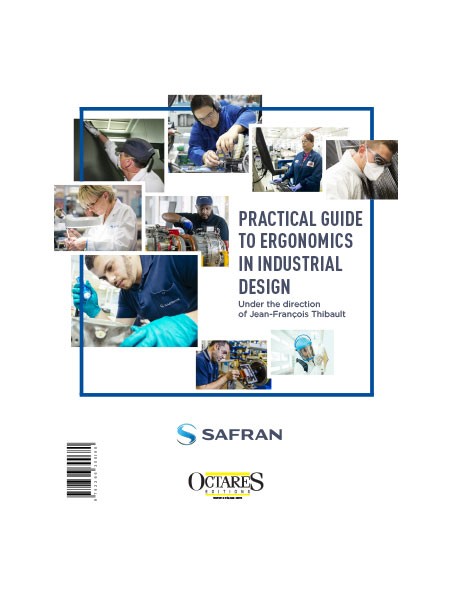 Agrandir l'image
Agrandir l'image
Pratical Guide to Ergonomic in Industrial Design
978-2-36630-068-0
Neuf
Jean-Francois Thibault
(Under the direction)
Confident in its considerable capacity for technical innovation in the elds of aeronautics,aerospace and defense, the Safran group is preparing its future and developing ever more effective products and services.
Confident in its considerable capacity for technical innovation in the elds of aeronautics, aerospace and defense, the Safran group is preparing its future and developing ever more effective products and services. This is how it?is meeting the expectations of its customers and other stakeholders by aiming for industrial excellence while constantly improving working conditions, in line with its commitment to sustainable development.
The Safran group has therefore drawn up and implemented an ambitious «Ergonomics program» which aims to :
- strengthen its occupational health and safety risk-prevention culture for the bene t of its staff, ?
- optimize its investments by including ergonomics at the project planning stage for the bene t of its customers and its economic performance.
Whether installing a new item of equipment or?a new production line, modernizing a workshop or building a new factory, every industrial investment project commits the future of a company and its employees: to get it right rst time, ergonomics must be included at the design phase.
This is why we have devised this practical guide which completes our campaign to improve ergonomics at all our sites.
We would like to see it used very widely, both within the group and beyond, to strengthen this culture of industrial excellence in the service of the men and women whose work is the bedrock of our success.
This practical and internationally oriented book is aimed at all the company's stakeholders (managers, designers, methods, prevention workers, occupational physicians, social partners, as well as, production, maintenance and logistics operators) who participate in the implementation of industrial investments in their company. It will also interest teachers and students in ergonomics as well as consultants and institutional ergonomists.
Jean-François Thibault joined the Safran Group in 2012 in the Sustainable Development Department with the mission of building and deploying an Ergonomics program in all the Group's sites (approximately 70,000 employees spread over 140 sites on 5 continents). In conjunction with the Group's Industrial Division, he also participates in the Usine du Futur project and manages a project of cobotic systems development project within the Safran group.
Prior to joining Safran, Jean-François Thibault was successively Director of the Regional Agency for the Improvement of Working Conditions in Aquitaine, consultant to numerous multinationals and also Associate Professor of Ergonomics at the University of Bordeaux. As such, he has about fifty scientific publications to his credit.
Introduction
What is Ergonomics for?
What is the scope of Ergonomics at Safran?
Why this guide?
Ergonomics initiative
Simulation tools
Prototyping and modeling
Full-scale prototype
Reduced-scale modeling
Digital simulations
Digital simulation of man-machine interface
Digital simulation of flow
CAD 3d simulation
Virtual reality simulation
Summary of types of simulation tools
Characteristics of workstations
Choice of type of workstation
Surfaces, volumes of work and position of controls
Sitting station (Europe and United States)
Raised sitting station or standing station?(Europe and United States)
Standing station (Europe and United States)
Positioning of controls (Europe and United States)
Sitting station (Asia and South America)
Sitting station or standing station (Asia and South America)
Positioning of controls (Asia and South America)
Special case of workstations at height
Types of protection
Platforms and walkways
Mobile elevating work platform (MEWP)
Visual information
Basic principles of information processing
Field of vision and postures
Positioning of visual signals
Character size, perception distances and color
Position of texts and “labels”
Colors and shapes of action buttonsand luminous signals
Types of display
Man/Machine Interface (MMI)
Process of designing an MMI
General rules of ergonomics
Structure of an overview
General bar zone
Menu zone
Window zone
Alarms zone
Viewing zone
Controls and data entry
View chaining
Characteristics of physical controls
Horizontal and vertical spatial organization
Front panels of control consoles
Postures and joint angulations
Load carrying
Recommended weight limits
Contents and quality of grip
Positioning of deposit and storage planes
Recommendations for “little train” bases with wheels
Assistance with load carrying and Assistance with handling
Load moving devices
Lifting devices
Gripping devices
Devices to reduce postural constraint and effort
Effort
Subjective approach to effort
Normative approach to effort
Limits of effort
Repeated maintained effort
Effort for pushing a trolley
Hand tools
Adaptation to the task and the user
Laterality
Working height
Effort due to use of hand tools
Weight of the tool
Center of gravity of the tool
Reaction torque
Command and activation system
Position
Maximum effort by type of hand tool
Characteristics of handles and shafts
Length and shape
Diameter
Materials and texture
Distance between handles
Vibrations
Noise
Temperature
Overhaul
Examples of hand tool design
Storage and packing
Containers
Physical modifications
Handling equipment
Mobile equipment
Static equipment
Stock management
Arrival Area
Storage
Examples of storage and packing
Accessibility
Pedestrian and trolley passageways
Work zones
Industrial space
Accessibility for certain specific operations
Hands-arms accessibility
Office type space in workshop
Access for people with reduced mobility (PRM)
Outdoor traffic flow and access
Indoor traffic flow and access
Annex premises
Access for working at heights
Guard-rail
Ramp
Stairs
Ladders
Physical working environment
Noise
Admissible noise levels and thresholds
Principles of noise reduction
Business services or business with a high
Ambient temperature
Lighting
Lighting levels
Glare
Vibrations
References
Ergonomics initiative and simulation tools
Characteristics of workstations
Design of Man/Machine Interfaces (MMI)
Postures and joint angulations
Load carrying
Effort
Hand tools
Storage and packing
Accessibility
Physical environment
| Auteur | Jean-Francois Thibault (Under the direction) |
| Hauteur | 25 cm |
| Largeur | 20 cm |
| Épaisseur | 2 cm |
| Poids (g) | 800 |
| Année | 2017 |
| Nombre de pages | 260 |


